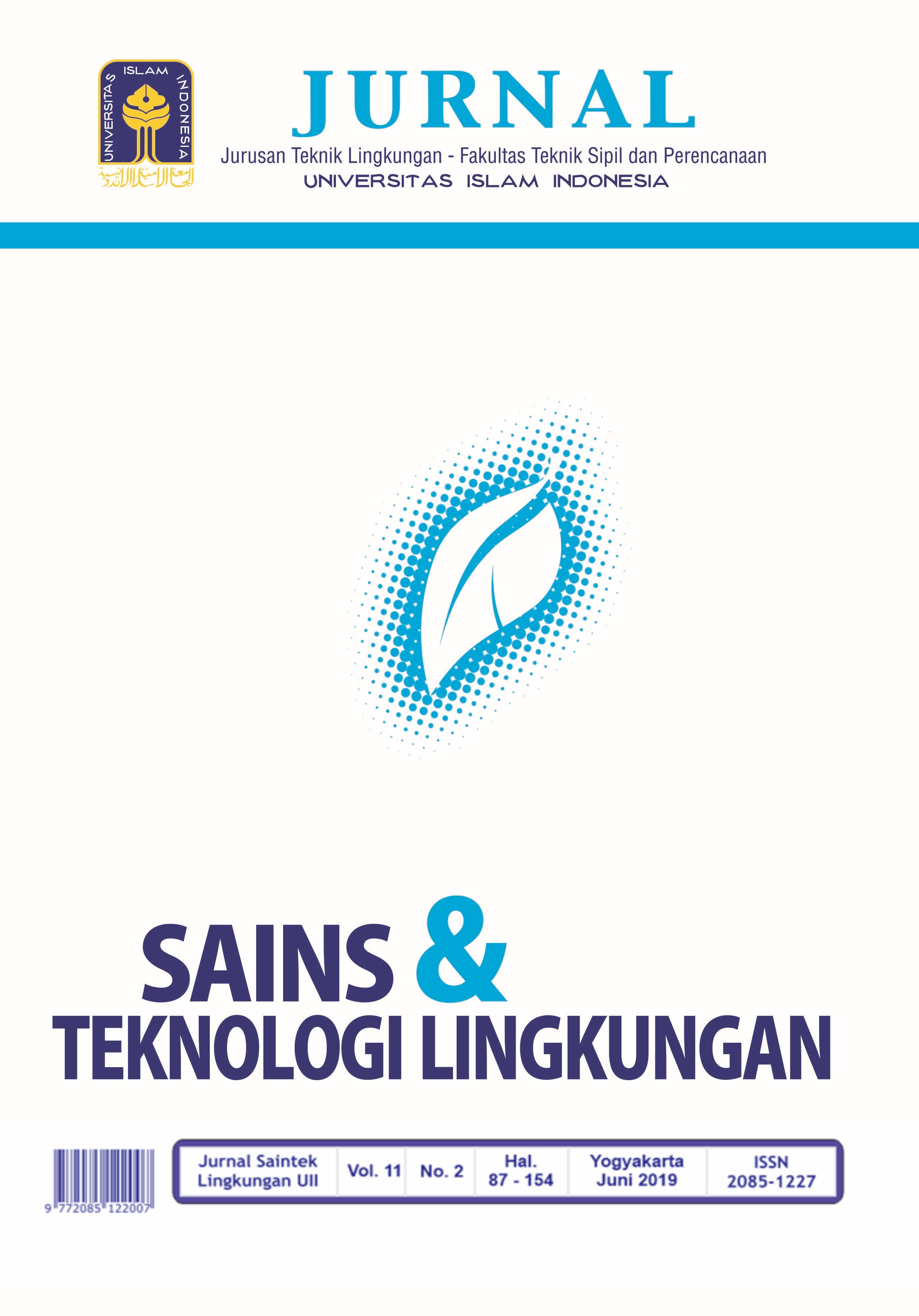Main Article Content
Abstract
Blotong is a solid waste produced from a refining station with a filtering mechanism for dirty sap in a vacuum filter with dirty roomie on a door clarifier, which has been added with additional ingredients. Blotong waste processing with digestion technology in the manufacture of new renewable energy is a very effective and efficient solution. The digestion process can run optimally, effectively and efficiently with regard to the content of C / N ratio, temperature, pH, and other supporting factors. The raw materials used are blotong from PT. Madu Baru Madukismo Yogyakarta. The raw material is mixed with cow dung and inoculum as a starter in the process of breeding methane bacteria. After all the ingredients are mixed then put in a reactor called a digester with a fermentation time of 50 days and an observation of the temperature, production, and content of methane in biogas is carried out. The materials put in the reactor varied with the composition of the blotong and cow manure, namely: 100%: 0%, 90%: 10%, 80%: 20%, 70%: 30%, 60%: 40%, 50%: 50 %. As for the inoculum as a starter in the biogas process, 30% of the total volume of the material is included. The purpose of this study is expected to be able to produce biogas with the optimal amount and quality of gas as an alternative fuel for the community
Keywords
Article Details
Authors who publish with this journal agree to the following terms:
- Authors retain copyright and grant the journal right of first publication with the work simultaneously licensed under a Creative Commons Attribution License that allows others to share the work with an acknowledgement of the work's authorship and initial publication in this journal.
- Authors are able to enter into separate, additional contractual arrangements for the non-exclusive distribution of the journal's published version of the work (e.g., post it to an institutional repository or publish it in a book), with an acknowledgement of its initial publication in this journal.
- Authors are permitted and encouraged to post their work online (e.g., in institutional repositories or on their website) prior to and during the submission process, as it can lead to productive exchanges, as well as earlier and greater citation of published work (See The Effect of Open Access).
References
- Dewani, Intan. (2010). Teknologi Pengelolaan dan Pemanfaatan Sampah/Limbah Perkotaan, Magister Sistem Teknik, UGM, Yogyakarta.
- Dharma, Untung Surya., Rajabiah, Nurlalila dan Setyadi, Chika. (2017). Pemanfaatan Limbah Blotong dan Bagase Menjadi Biobriket dengan Perekat Berbahan Baku Tetes Tebu dan Setilage. Jurnal Teknik Mesin Univ. Muhammadiyah Metro, 6(1).
- Dioha., I.J., Ikeme., C.H., Nafi’u, T., So., N.I. Soba, and Yusuf., M.B.S. (2013). Effect of Carbon to Nitrogen Ratio on Biogas production. International research Journal of natural Sciences, 1 (3):1-10.
- Harahap F., M. Apandi, dan S. Ginting. (1978). Teknologi Biogas, Pusat Teknologi Pembangunan Institut Teknologi, Bandung.
- Ismayana, Andes., Indrasti, Nastiti Siswi., Suprihatin., Maddu, Akhiruddin dan Fredy, Aris. (2012). Faktor Rasio C/N Awal dan Laju Aerasi pada Proses Co-Composting Bagasse dan Blotong. Jurnal Teknologi Industri Pertanian, 22 (3):173-179
- Janke, L., Leite, A., Nikolausz, M., Schimdt, T., Liebetrau, J., Nelles, M., and Stinner, W. (2015). Biogas Production from sugarcane waste: Assessment on Kinetic Challenges for Process Designing. International Journal of Molecular Sciences. ISSN 1422-0067.Vol 16, 20685-20703.
- Kurniasari Heni Dwi, (2010), Pemanfaatan Sludge Limbah Biodigester untuk Meningkatkan Kecepatan Produksi Biogas dan Konsentrasi Gas Metan dalam Biogas, UGM, Yogyakarta
- Sasongko Pramono, Tantalu Lorine, (2018), Fermentasi Blotong Limbah PG.Krebet dan Rumen Sapi Dalam Produksi Biogas, Jurnal Buana Sains, 18 (2): 131-138
- Supari.,Taufik dan Gunawan, Budi. (2015). Analisa Kandungan Kimia Pupuk Organik Dari Blotong Tebu Limbah Dari Pabrik Gula. Prosiding Seminar Nasional Sains dan Teknologi, Fakultas Teknik universitas Wahid Hasyim Semarang, 1(1) :10-13.
- Suyitno., Nizam, Muhammad dan Dharmanto. (2012). Teknologi Biogas Pembuatan Operasional dan Pemanfaatan. Yogyakarta : Graha Ilmu
- Tchobanoglous,G., Burton, F.L dan Stensel,H.D. (1991). Wastewater Engineering Treatment and Reuse 4th ed, McGraw-Hill Book Company, New York.
- Untung, Surya Dharma dan Hamim, Bustomi. (2017). Pengaruh Temperatur Digester Sistem Kontinyu Terhadap Produksi Biogas Berbahan Baku Blotong, Jurnal Teknik Mesin Univ. Muhammadiyah Metro, 6 (2), ISSN : 2301-6663
References
Dewani, Intan. (2010). Teknologi Pengelolaan dan Pemanfaatan Sampah/Limbah Perkotaan, Magister Sistem Teknik, UGM, Yogyakarta.
Dharma, Untung Surya., Rajabiah, Nurlalila dan Setyadi, Chika. (2017). Pemanfaatan Limbah Blotong dan Bagase Menjadi Biobriket dengan Perekat Berbahan Baku Tetes Tebu dan Setilage. Jurnal Teknik Mesin Univ. Muhammadiyah Metro, 6(1).
Dioha., I.J., Ikeme., C.H., Nafi’u, T., So., N.I. Soba, and Yusuf., M.B.S. (2013). Effect of Carbon to Nitrogen Ratio on Biogas production. International research Journal of natural Sciences, 1 (3):1-10.
Harahap F., M. Apandi, dan S. Ginting. (1978). Teknologi Biogas, Pusat Teknologi Pembangunan Institut Teknologi, Bandung.
Ismayana, Andes., Indrasti, Nastiti Siswi., Suprihatin., Maddu, Akhiruddin dan Fredy, Aris. (2012). Faktor Rasio C/N Awal dan Laju Aerasi pada Proses Co-Composting Bagasse dan Blotong. Jurnal Teknologi Industri Pertanian, 22 (3):173-179
Janke, L., Leite, A., Nikolausz, M., Schimdt, T., Liebetrau, J., Nelles, M., and Stinner, W. (2015). Biogas Production from sugarcane waste: Assessment on Kinetic Challenges for Process Designing. International Journal of Molecular Sciences. ISSN 1422-0067.Vol 16, 20685-20703.
Kurniasari Heni Dwi, (2010), Pemanfaatan Sludge Limbah Biodigester untuk Meningkatkan Kecepatan Produksi Biogas dan Konsentrasi Gas Metan dalam Biogas, UGM, Yogyakarta
Sasongko Pramono, Tantalu Lorine, (2018), Fermentasi Blotong Limbah PG.Krebet dan Rumen Sapi Dalam Produksi Biogas, Jurnal Buana Sains, 18 (2): 131-138
Supari.,Taufik dan Gunawan, Budi. (2015). Analisa Kandungan Kimia Pupuk Organik Dari Blotong Tebu Limbah Dari Pabrik Gula. Prosiding Seminar Nasional Sains dan Teknologi, Fakultas Teknik universitas Wahid Hasyim Semarang, 1(1) :10-13.
Suyitno., Nizam, Muhammad dan Dharmanto. (2012). Teknologi Biogas Pembuatan Operasional dan Pemanfaatan. Yogyakarta : Graha Ilmu
Tchobanoglous,G., Burton, F.L dan Stensel,H.D. (1991). Wastewater Engineering Treatment and Reuse 4th ed, McGraw-Hill Book Company, New York.
Untung, Surya Dharma dan Hamim, Bustomi. (2017). Pengaruh Temperatur Digester Sistem Kontinyu Terhadap Produksi Biogas Berbahan Baku Blotong, Jurnal Teknik Mesin Univ. Muhammadiyah Metro, 6 (2), ISSN : 2301-6663
